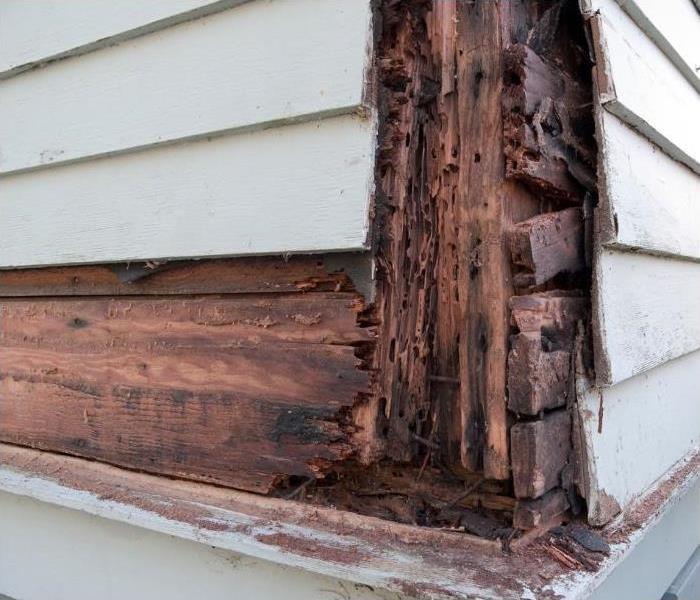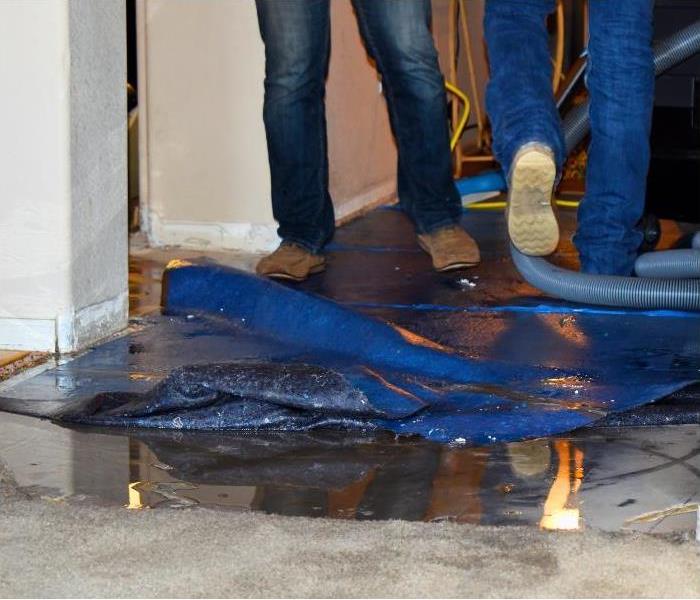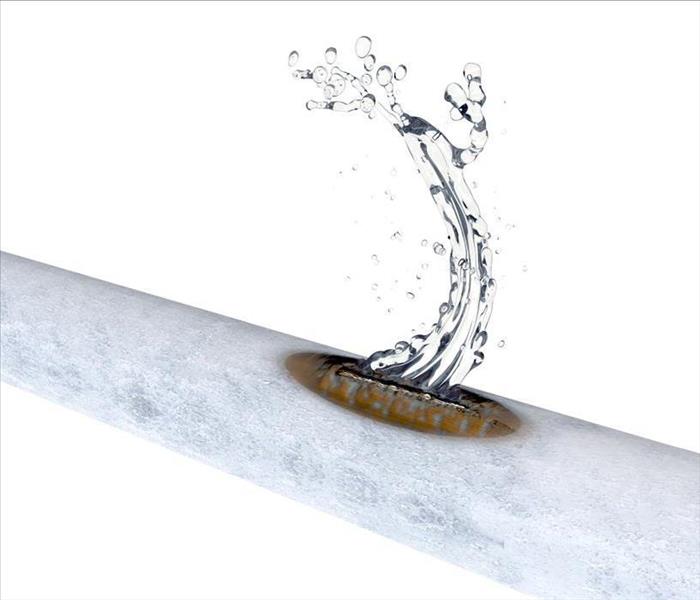Archived Storm Damage Blog Posts
3 Things to Avoid Doing After a Flood in Salt Lake City, UT
9/2/2024 (Permalink)
 Flood in Salt Lake City, UT
Flood in Salt Lake City, UT
Flooding can be a devastating experience for homeowners, especially in areas like Salt Lake City, UT, where sudden storms and heavy snowmelt can lead to unexpected deluges. Once the waters recede, it's crucial to act quickly and wisely to mitigate damage and ensure a safe return to normalcy. However, there are several common mistakes that homeowners often make in the aftermath of a flood. Avoiding these pitfalls can make a significant difference in the recovery process. Here are three things to avoid doing after a flood in Salt Lake City.
1. Ignoring Safety Precautions
Safety should be your top priority after a flood. It's tempting to jump straight into cleanup efforts, but doing so without proper precautions can be dangerous. Here are key safety measures to keep in mind:
Avoid Entering Unsafe Structures: Floodwaters can weaken the structural integrity of your home. Before entering, check for damage such as cracks in the foundation or shifting of the building. It's essential to have a professional inspect the property before you step inside.
Beware of Electrical Hazards: Water and electricity are a dangerous combination. Do not touch electrical appliances or outlets if they are wet. Turn off the power to your home from the main breaker if you suspect electrical damage or if you see water near electrical sources. Only turn the power back on once a licensed electrician has assessed the safety of your system.
Use Protective Gear: Floodwaters can be contaminated with sewage, chemicals, and other hazardous materials. Always wear protective clothing, including gloves, boots, and a mask, to minimize your exposure to these contaminants.
2. Delaying Cleanup and Restoration
Time is of the essence when it comes to flood damage. Delaying cleanup can lead to more severe problems, such as mold growth and structural deterioration. Here’s why you should avoid procrastinating:
Mold Growth: Floodwaters introduce moisture that can lead to mold growth within 24-48 hours. Mold not only poses health risks but also can be challenging and expensive to remove once it establishes itself. Start drying out your home as soon as possible. Use dehumidifiers, fans, and open windows to speed up the drying process. For extensive water damage, consider hiring a professional restoration service to ensure thorough drying and prevent mold development.
Structural Damage: Water can cause wood to swell, warp, and rot, leading to long-term structural issues. Promptly remove and replace damaged materials such as drywall, insulation, and flooring. If you delay, you risk further damage that could compromise the safety of your home and result in more costly repairs.
Salvageable Items: The sooner you begin sorting through your belongings, the better chance you have of salvaging items. Remove wet furniture, clothing, and personal items and assess what can be cleaned or needs to be discarded. Properly clean and disinfect salvageable items to prevent further damage and contamination.
3. Attempting DIY Repairs Beyond Your Expertise
While some cleanup tasks can be manageable for a homeowner, others require professional expertise. Avoid taking on repairs that are beyond your skill level, as this can lead to further complications. Here’s when to call in the pros:
Complex Water Damage Restoration: If the flood has caused extensive damage, such as compromised structural elements or significant water damage to walls and ceilings, it’s best to hire a professional restoration service. Professionals have the equipment and expertise to handle complex issues like extensive water extraction, structural repairs, and thorough drying.
Mold Remediation: If you notice mold growth or suspect hidden mold, do not attempt to handle it yourself. Mold remediation requires specialized equipment and techniques to safely remove mold and prevent its return. Professional mold remediation services can ensure that the problem is fully addressed and that your home is safe to inhabit.
Insurance Claims and Repairs: Navigating insurance claims can be tricky. Professionals in flood damage restoration often work closely with insurance companies and can assist in documenting damage, filing claims, and ensuring that you receive the compensation you're entitled to. They can also provide accurate estimates for repairs and restoration, which can be crucial for your insurance process.
Floods can leave a lasting impact on your home and your peace of mind. By avoiding these common mistakes—ignoring safety precautions, delaying cleanup, and attempting DIY repairs beyond your expertise—you can better manage the aftermath of a flood and facilitate a smoother recovery process. In Salt Lake City, where flood risks are a reality, staying informed and prepared is key. Remember that professional help is available, and utilizing their services can make a significant difference in your recovery journey. Prioritize safety, act swiftly, and seek expert assistance to ensure your home and health are protected during this challenging time.
Storm Damage Remediation Steps in Salt Lake City, UT: A Comprehensive Guide
7/3/2024 (Permalink)
 Storm Damage Remediation in Salt Lake City, UT
Storm Damage Remediation in Salt Lake City, UT
Salt Lake City, nestled against the picturesque backdrop of the Wasatch Mountains, enjoys its fair share of natural beauty and outdoor activities. However, like many places, it is also susceptible to severe weather events, including storms that can wreak havoc on homes and properties. From heavy rains to fierce winds and occasional snowstorms, these weather patterns can lead to significant damage, requiring prompt and effective remediation efforts.
1. Understanding Storm Damage
Storm damage in Salt Lake City can take various forms depending on the season and the severity of the weather event. Common types of storm damage include:
Roof Damage: High winds and heavy precipitation can cause shingle damage, leaks, or even structural issues to roofs.
Water Damage: Flooding from heavy rains or snowmelt can infiltrate homes, causing damage to walls, floors, and belongings.
Tree Damage: Falling branches or uprooted trees can damage roofs, windows, and siding.
Siding and Window Damage: Strong winds can impact siding and windows, leading to cracks, breaks, or complete detachment.
Foundation Issues: Excessive rain or snowmelt can saturate the soil around foundations, potentially causing shifts or cracks.
2. Immediate Steps After a Storm
When a storm hits Salt Lake City and damages your property, taking immediate action is crucial to mitigate further harm and begin the remediation process:
Safety First: Ensure everyone's safety. If there are any immediate hazards such as downed power lines or structural instability, evacuate the premises and contact emergency services.
Assess Damage: Conduct a thorough inspection of your property to assess the extent of the damage. Document everything for insurance purposes, including taking photos or videos if possible.
Temporary Repairs: If safe to do so, undertake temporary repairs to prevent further damage. This could include tarping a damaged roof, boarding up broken windows, or drying out waterlogged areas.
Contact Your Insurance Provider: Notify your insurance company as soon as possible to begin the claims process. Provide them with detailed documentation and keep records of all communications.
3. Steps for Storm Damage Remediation
Once the initial steps are completed, the process of storm damage remediation in Salt Lake City typically involves several key phases:
1. Water Damage Restoration
If your home has suffered from flooding or water infiltration:
Water Extraction: Use pumps and vacuums to remove standing water from affected areas.
Drying and Dehumidification: Employ industrial-grade dehumidifiers and air movers to thoroughly dry out walls, floors, and carpets.
Mold Prevention: Treat potential mold growth areas with antimicrobial solutions to prevent mold and mildew formation.
2. Roof and Structural Repairs
Addressing roof and structural damage is crucial for ensuring the integrity of your home:
Roof Inspection and Repair: Hire qualified professionals to inspect and repair roof damage. This may involve replacing missing shingles, repairing leaks, or even replacing sections of the roof if necessary.
Structural Assessment: Check for any structural damage to walls, ceilings, or foundations. Reinforce or repair as needed to maintain stability.
3. Siding, Window, and Exterior Repairs
Repair or replace damaged siding, windows, and other exterior components:
Siding Replacement: Replace cracked or detached siding panels to restore insulation and aesthetic appeal.
Window Repair or Replacement: Repair broken windows or replace them with energy-efficient alternatives.
Exterior Inspection: Conduct a thorough inspection of exterior walls and surfaces for hidden damage that could lead to future issues.
4. Landscape and Tree Care
Address any landscaping issues and remove hazards posed by fallen trees or branches:
Tree Removal: Safely remove fallen trees or branches that pose a risk to structures or safety.
Landscape Restoration: Repair landscaping features such as gardens, fences, or pathways damaged during the storm.
5. Final Inspections and Documentation
Once remediation efforts are complete, perform final inspections to ensure all repairs meet safety and quality standards:
Quality Assurance: Verify that all repairs and replacements have been completed to your satisfaction.
Documentation: Keep detailed records of all repairs, receipts, and communications with contractors and insurance providers for future reference.
Navigating storm damage remediation in Salt Lake City requires a proactive approach, attention to safety, and timely coordination with professionals and insurance providers. By following these comprehensive steps, homeowners can effectively restore their properties and minimize the long-term impact of severe weather events. Remember, prompt action and thorough documentation are key to a successful recovery from storm damage.
How to Handle Frozen Pipes
12/28/2023 (Permalink)
 A frozen pipe in Downtown Salt Lake City, UT.
A frozen pipe in Downtown Salt Lake City, UT.
Running water is a necessity in every home, but a busted pipe can easily become a nuisance rather than a convenience. Every homeowner in Downtown Salt Lake City, UT, should know how to handle a frozen pipe and some basic pipe freeze prevention tips.
3 Tips To Consider As Regards Frozen Pipes
1. Frozen Pipe Assessment
If the water from a faucet only comes out in a slow drip when it's turned on, this is a common sign that you have frozen pipes. To locate the source of the problem without exacerbating it, you need to follow several steps:
- Turn off water flow to the pipe that feeds the faucet.
- Open the faucet.
- Trace the path of the pipes leading from the faucet.
- Look for ice, bulges or breaks.
The location of the freeze determines your next move. If the pipe itself is already damaged, you will need a plumber to repair it before you turn the water back on. A layer of frost or ice on intact pipes can usually be melted to save them. Use a hair dryer or portable heater to warm the area around the pipe.
If the pipe is inside the wall, you can turn up the heat in your home, but unless the wall is open, you don't really know what's going on behind it. It's best to hire a professional to find out before you let it fill with water again.
2. Pipe Freeze Prevention
It's good to know how to handle a frozen pipe. The best solution, however, is to keep it from frosting over in the first place. A few pipe freeze prevention strategies can go a long way toward protecting your home from water damage.
When the weather dips below the freezing point, let your faucets drip to keep water flowing through the pipes. Keep cabinets that enclose the pipes open, and insulate all the pipes you can see.
Make sure your thermostat is set to a warm temperature, and consider installing extra heaters in colder areas of your home. Protect outside pipes and those along exterior walls or in the garage by turning off the water source and draining them.
3. Water Damage Remediation
If you already have a burst pipe in your house, you probably also have some water damage to the area surrounding it. Fast action is necessary to prevent the problem from becoming worse. First, turn off the water supply to the pipe to prevent more moisture from leaking out. Then, call water damage mitigation experts to get the cleanup process started quickly.
Basic remediation starts by tearing out ruined materials. Drenched drywall and insulation will need to be replaced, but textiles such as carpets can usually be salvaged as long as the water that touches them comes directly from a clean source (e.g., a supply line or pipe). Then the technicians will dry and clean the area. Finally, they rebuild the structure to make your home look as good as new.
Frozen pipes are a warning sign that fissures may be forming in your plumbing. Once they burst, you have a mess on your hands. A solid understanding of pipe freeze prevention helps you protect your home from water damage.

 24/7 Emergency Service
24/7 Emergency Service


